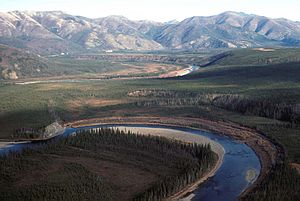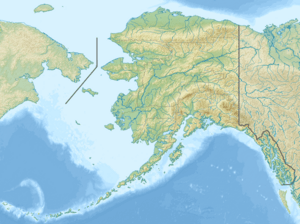Beaver Creek (Yukon River tributary) facts for kids
Quick facts for kids Beaver Creek |
|
|---|---|

Beaver Creek in Yukon Flats
|
|
|
Location of the mouth of Beaver Creek in Alaska
|
|
| Native name | Taatthee Niign |
| Country | United States |
| State | Alaska |
| Census Area | Yukon–Koyukuk |
| Physical characteristics | |
| Main source | confluence of Champion and Bear creeks White Mountains National Recreation Area 65°24′56″N 146°59′04″W / 65.41556°N 146.98444°W |
| River mouth | Yukon River south-southwest (downstream) of Beaver, Yukon Flats National Wildlife Refuge 335 ft (102 m) 66°14′19″N 147°31′58″W / 66.23861°N 147.53278°W |
| Length | 180 mi (290 km) |
| Type: | Wild |
| Designated: | December 2, 1980 |
Beaver Creek is a long river in Alaska, a state in the United States. It's about 180 miles (290 km) long. This creek flows into the mighty Yukon River. In the Upper Tanana language, it is called Taatthee Niign.
The creek starts where two smaller streams, Champion and Bear creeks, meet. This spot is in the White Mountains National Recreation Area. It's about 50 miles (80 km) north of Fairbanks. From there, Beaver Creek flows west, then northeast, and finally west again to join the Yukon River.
A special part of Beaver Creek, about 127 miles (204 km) long, is protected. In 1980, it became part of the National Wild and Scenic Rivers System. This means it's kept wild and beautiful for everyone to enjoy. Most of this protected section is within the recreation area. The last 16 miles (26 km) are inside the Yukon Flats National Wildlife Refuge.
Contents
What is Beaver Creek Like?
Beaver Creek flows through different kinds of landscapes. Near its start, it goes through thick forests. These forests have tall white spruce and paper birch trees. You can also see open tundra on the high slopes of the White Mountains.
The White Mountains have tall limestone peaks. Some of these peaks reach up to 3,176 feet (968 meters) high. Along the creek's banks, you'll find many gravel bars and willow bushes.
Flowing Through Yukon Flats
The lower part of Beaver Creek winds its way through an area called Yukon Flats. This area is very flat and has thousands of lakes. You'll see many interesting water features here. These include sloughs (small channels) and oxbow lakes. Oxbow lakes are U-shaped lakes that form when a river changes its path.
Beaver Creek is part of a busy river system. This system is one of the best places in North America for waterfowl (like ducks and geese) to breed. It's the most important breeding area for waterfowl in all of Alaska.
Fun Activities on Beaver Creek
Many people enjoy visiting Beaver Creek for outdoor adventures. The most popular way to see the lower part of the creek is by floating downstream. You can also land small planes on the gravel bars.
Getting to the Creek
You can reach the upper part of Beaver Creek through Nome Creek. Nome Creek flows into Beaver Creek a few miles from where it starts. It's easy to get to Nome Creek by driving on a highway. If the water level is high enough, you can also boat upstream from the Yukon River to reach the lower parts of Beaver Creek.
Boating and Floating
Beaver Creek is considered "Class I" (easy) on the International Scale of River Difficulty. This means it's suitable for many types of boats. You can float down the creek in canoes, kayaks, or rafts.
The section from Nome Creek to Victoria Creek is about 100 miles (160 km) long. Here, Beaver Creek is usually 75 to 150 feet (23 to 46 meters) wide. It's also about 2 to 4 feet (0.6 to 1.2 meters) deep. Further downstream, in the wildlife refuge, the river gets even wider and deeper. It also has wide gravel bars.
Boaters should be careful of overhanging trees, stumps, and logs. These can be partly underwater and might be a hazard.
Fishing in Beaver Creek
If you like fishing, Beaver Creek is a great spot! Fishing for northern pike and Arctic grayling can be "outstanding." This is according to a book called Alaska Fishing.
- Northern Pike: These larger fish are often found in the lower parts of the creek. They also like the sloughs, ponds, and oxbow lakes in the Yukon Flats.
- Arctic Grayling: These fish prefer the cooler, clearer waters near the headwaters of the creek.


